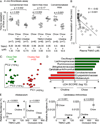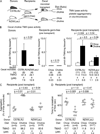Gut Microbial Metabolite TMAO Enhances Platelet Hyperreactivity and Thrombosis Risk
- PMID: 26972052
- PMCID: PMC4862743
- DOI: 10.1016/j.cell.2016.02.011
Gut Microbial Metabolite TMAO Enhances Platelet Hyperreactivity and Thrombosis Risk
Abstract
Normal platelet function is critical to blood hemostasis and maintenance of a closed circulatory system. Heightened platelet reactivity, however, is associated with cardiometabolic diseases and enhanced potential for thrombotic events. We now show gut microbes, through generation of trimethylamine N-oxide (TMAO), directly contribute to platelet hyperreactivity and enhanced thrombosis potential. Plasma TMAO levels in subjects (n > 4,000) independently predicted incident (3 years) thrombosis (heart attack, stroke) risk. Direct exposure of platelets to TMAO enhanced sub-maximal stimulus-dependent platelet activation from multiple agonists through augmented Ca(2+) release from intracellular stores. Animal model studies employing dietary choline or TMAO, germ-free mice, and microbial transplantation collectively confirm a role for gut microbiota and TMAO in modulating platelet hyperresponsiveness and thrombosis potential and identify microbial taxa associated with plasma TMAO and thrombosis potential. Collectively, the present results reveal a previously unrecognized mechanistic link between specific dietary nutrients, gut microbes, platelet function, and thrombosis risk.
Copyright © 2016 Elsevier Inc. All rights reserved.
Figures







, G protein q; IP<3>, inositol 1,4,5-triphosphate; IP<3>R, Inositol 1,4,5-triphosphate receptor; P2Y12, purinergic receptor P2Y12; PAR, protease activated receptor; PLC, phospholipase C; PIP2, phosphatidylinositol 4,5-bisphosphate.
Comment in
-
Thrombosis: Gut microbes modulate platelet function and thrombosis risk.Nat Rev Cardiol. 2016 May;13(5):247. doi: 10.1038/nrcardio.2016.47. Epub 2016 Mar 24. Nat Rev Cardiol. 2016. PMID: 27009421 No abstract available.
-
The Plot Thickens: Diet Microbe Interactions May Modulate Thrombosis Risk.Cell Metab. 2016 Apr 12;23(4):573-5. doi: 10.1016/j.cmet.2016.03.017. Cell Metab. 2016. PMID: 27076072
References
Publication types
MeSH terms
Substances
Grants and funding
- R01HL103866/HL/NHLBI NIH HHS/United States
- R01 HL103931/HL/NHLBI NIH HHS/United States
- HL28481/HL/NHLBI NIH HHS/United States
- P20 HL113452/HL/NHLBI NIH HHS/United States
- UL1 TR000439/TR/NCATS NIH HHS/United States
- HL30568/HL/NHLBI NIH HHS/United States
- R01 HL122283/HL/NHLBI NIH HHS/United States
- P01 HL030568/HL/NHLBI NIH HHS/United States
- P40 OD010995/OD/NIH HHS/United States
- R01 DK106000/DK/NIDDK NIH HHS/United States
- R01 HL103866/HL/NHLBI NIH HHS/United States
- P30 DK034987/DK/NIDDK NIH HHS/United States
- P01 HL028481/HL/NHLBI NIH HHS/United States
- P01 HL076491/HL/NHLBI NIH HHS/United States
- P20HL113452/HL/NHLBI NIH HHS/United States
- P01 HL098055/HL/NHLBI NIH HHS/United States
- S10 OD016346/OD/NIH HHS/United States
- R01 HL111614/HL/NHLBI NIH HHS/United States
- R01DK106000/DK/NIDDK NIH HHS/United States
LinkOut - more resources
Full Text Sources
Other Literature Sources
Medical
Miscellaneous

